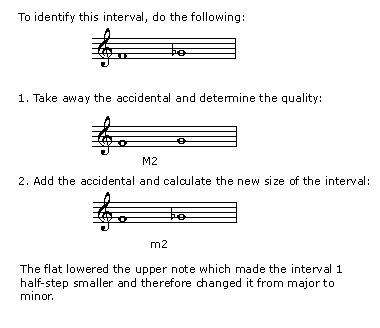WHITE NOTE INTERVALS
One useful method for identifying intervals is to
figure out what the interval is without any accidentals and then
calculate how each accidental alters the size of the interval. Let's
start with 2nds and 7ths. When there are no accidentals (white-note
intervals) there are two pairs of notes that produce minor 2nds
(m2) and major 7ths (M7). Remember that when you invert a minor
intervals invertal it will become major and that 2nds invert to
become 7ths. The two white note m2 occur between e-f, and b-c (look
on the piano - these are the pairs where there is no black key inbetween).

m2 M7
All other pairs of white-note 2nds and 7ths will be
M2 or m7.
Remember also the following: when you make a minor
interval 1 half-step larger it becomes major and vice versa. A major
interval made larger becomes augmented and a minor interval made
smaller becomes diminished. This can be represented by the following
sequence going from smallest to largest: d - m - M - A.
The perfect intervals arranged from smallest to largest
look like this: d - P - A.
To apply this technique to an interval perform the
following steps:

Fourths and fifths are even easier. There is only
one pair of white-notes that are not perfect, b-f or f-b:

All other white-note 4ths and 5ths are perfect! If the two notes
that form your 4th or 5th are not b and f, then you are dealing
with a perfect interval.
Gotta quit now - more to come later!
|

